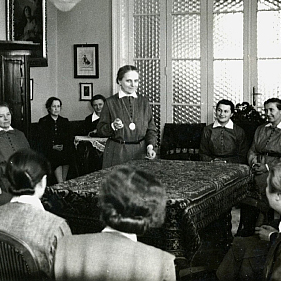History
EARLY YEARS
BEFORE OUR SOCIETY
Our community, the Society of the Sisters of Social Service, as we know it today, bears the mark of several great personalities, all of whom were inspired by pope Leo XIII’s Rerum Novarum, the first of the great encyclicals calling for social justice. In Hungary, by the turn of the 20th century, there was already a growing Catholic Women’s Movement, whose activities were in harmony with, and whose leaders were inspired by this document. Edith Farkas, Executive Secretary of the movement, encouraged by Bishop Ottokar Prohaszka, founded the Social Mission Society on November 19, 1908. Canonically, no-one envisioned a religious congregation.


MARGARET SLACHTA
THE FOUNDRESS OF OUR SOCIETY
Margaret Slachta not only quickly made her own the vision of Edith Farkas and Ottokar Prohaszka, but developed creative ways of enfleshing that vision. She was a pioneer in the field of social work, developing means of direct service, organizing women not only to heal the wounds around them, but to work toward changing the conditions that caused the wounds. She trained women for political action and was herself the first woman to sit in the parliament of Hungary. Sister Margaret was a woman of great courage and broad vision who saw the social mission of the Church as embracing all of the pressing needs of the human family.
FOUNDATION
OF OUR SOCIETY
The Sisters of Social Service was founded on May 12, 1923 by Sister Margaret Slachta with sisters who wished to retain and develop the original charisma. The new Society would send into any social area where needs arose, women consecrated to the Lord, competent in their fields of service, contemporary in their approach. The scope of the ministry was conceptualized by her in the form of a pyramid. The base of the pyramid consists of the works of charity. The second level comprises social service. The third level consists of movements, and the top of the pyramid is the political ministry.

EXPANSION
TO THE WORLD
As our community grew, the mother district in Budapest sent sisters to make foundations, several of which became districts of their own.
(to stop scrolling carousel, show with cursor on it)
EXPANSION
TO THE WORLD
As our community grew, the mother district in Budapest sent sisters to make foundations, several of which became districts of their own.
(to stop scrolling slides below, tap on it for one second / to start scrolling, just click on it)
MILESTONES
OF OUR HISTORY

1940 - 1949
The Second World War and the terrible persecution of the Jews which it engendered, led Sr. Margaret to make heroic efforts to save the persecuted. They were hidden in our motherhouse and in every house where our Sisters lived. Sister Sara Salkahazi (at the image) was martyred for this cause. On the evening of December 27, 1944 six people were stripped naked and shot into the icy Danube. Her Beatification took place in Budapest, on September 17, 2006. Along with the rescue efforts Sr. Margaret also had a leading role in the resistance to Nazi ideology. She gave talks and organized study days and courses on the values of the Gospel and on the evil of racism. During the Second World War and the terrible years of persecution of the Jewish people, the Sisters of Social Service rescued about a thousand of individuals.

1949 - 1989
After World War II there came a drastic change in the political climate of the countries of Central and Eastern Europe. Soviet occupation gave rise to communism, which brought along the persecution of the Church, the nationalization of Church run institutions, and the suppression of religious orders. Many Sisters in the three European districts were arrested and imprisoned for long terms (10-13 years), and some had to flee their countries. In 1949 Sr. Margaret was forced to leave her native Hungary for political reasons and she moved the general government of the Society to Buffalo NY, where some Sisters lived and worked since the 1920’s. The Districts in Romania and and Czechoslovakia were supressed in 1949, the Hungarian District in 1950. In spite of the difficulties during the forty years of illegality, God continued to call young women to join our community. They entered secretly, often without the knowledge of their own families. In 1955, the California and the Canadian districts became an autonomous institute with headquarters in Los Angeles. In 1977, the Sisters in Hamilton (Canada) became autonomous. The Federation of the Sisters of Social Service was established in 1972. It is comprised of three autonomous branches: SSS of California, SSS of Canada, and our SSS branch, headquartered in Buffalo, NY and since 1998 in Budapest, Hungary.
Illustration photo: www.sdke.sk

1989 - 1998
In 1989 the collapse of communism in Eastern Europe brought political freedom and opened a new era in the history of the community. Since 1990 the Sisters in Eastern European districts have been able to live their vocation freely. They serve God’s people in various ministries, according to the pressing needs of their own countries. In 1998 the Generalate of the Sisters of Social Service officially returned to Hungary and its principal seat is again in Budapest in the Archdiocese of Esztergom-Budapest. In a decree issued on December 8, 1998, on the feast of the Immaculate Conception of the Blessed Virgin Mary the Congregation of Consecrated Life (CICLSAL) declared that the Society of Apostolic Life of the Sisters of Social service is to be considered as of pontifical right.




